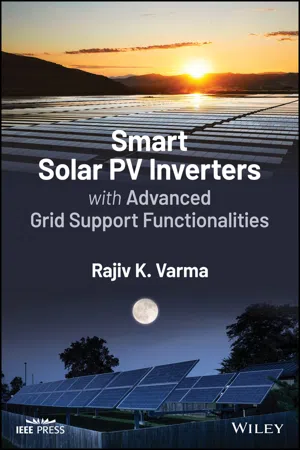
- English
- ePUB (mobile friendly)
- Available on iOS & Android
Smart Solar PV Inverters with Advanced Grid Support Functionalities
About this book
Learn the fundamentals of smart photovoltaic (PV) inverter technology with this insightful one-stop resource
Smart Solar PV Inverters with Advanced Grid Support Functionalities presents a comprehensive coverage of smart PV inverter technologies in alleviating grid integration challenges of solar PV systems and for additionally enhancing grid reliability. Accomplished author Rajiv Varma systematically integrates information from the wealth of knowledge on smart inverters available from EPRI, NREL, NERC, SIWG, EU-PVSEC, CIGRE, IEEE publications; and utility experiences worldwide. The book further presents a novel, author-developed and patented smart inverter technology for utilizing solar PV plants both in the night and day as a Flexible AC Transmission System (FACTS) Controller STATCOM, named PV-STATCOM. Replete with case studies, this book includes over 600 references and 280 illustrations.
Smart Solar PV Inverters with Advanced Grid Support Functionalities' features include:
- Concepts of active and reactive power control; description of different smart inverter functions, and modeling of smart PV inverter systems
- Distribution system applications of PV-STATCOM for dynamic voltage control, enhancing connectivity of solar PV and wind farms, and stabilization of critical motors
- Transmission system applications of PV-STATCOM for improving power transfer capacity, power oscillation damping (POD), suppression of subsynchronous oscillations, mitigation of fault induced delayed voltage recovery (FIDVR), and fast frequency response (FFR) with POD
- Hosting capacity for solar PV systems, its enhancement through effective settings of different smart inverter functions; and control coordination of smart PV inverters
- Emerging smart inverter grid support functions and their pioneering field demonstrations worldwide, including Canada, USA, UK, Chile, China, and India.
Perfect for system planners and system operators, utility engineers, inverter manufacturers and solar farm developers, this book will prove to be an important resource for academics and graduate students involved in electrical power and renewable energy systems.
Frequently asked questions
- Essential is ideal for learners and professionals who enjoy exploring a wide range of subjects. Access the Essential Library with 800,000+ trusted titles and best-sellers across business, personal growth, and the humanities. Includes unlimited reading time and Standard Read Aloud voice.
- Complete: Perfect for advanced learners and researchers needing full, unrestricted access. Unlock 1.4M+ books across hundreds of subjects, including academic and specialized titles. The Complete Plan also includes advanced features like Premium Read Aloud and Research Assistant.
Please note we cannot support devices running on iOS 13 and Android 7 or earlier. Learn more about using the app.
Information
1
IMPACTS OF HIGH PENETRATION OF SOLAR PV SYSTEMS AND SMART INVERTER DEVELOPMENTS
1.1 Concepts of Reactive and Active Power Control
1.1.1 Reactive Power Control
1.1.1.1 Voltage Control



Table of contents
- COVER
- TABLE OF CONTENTS
- SERIES PAGE
- TITLE PAGE
- COPYRIGHT PAGE
- DEDICATION PAGE
- ABOUT THE AUTHOR
- FOREWORD
- PREFACE
- ACKNOWLEDGMENTS
- LIST OF ABBREVIATIONS
- 1 IMPACTS OF HIGH PENETRATION OF SOLAR PV SYSTEMS AND SMART INVERTERDEVELOPMENTS
- 2 SMART INVERTER FUNCTIONS
- 3 MODELING AND CONTROL OF THREE‐PHASE SMART PV INVERTERS
- 4 PV‐STATCOM: A NEW SMART PV INVERTER AND A NEW FACTS CONTRO
- 5 PV‐STATCOM APPLICATIONS IN DISTRIBUTION SYSTEMS
- 6 PV‐STATCOM APPLICATIONS IN TRANSMISSION SYSTEMS
- 7 INCREASING HOSTING CAPACITY BY SMART INVERTERS – CONCEPTS AND APPLICATIONS
- 8 CONTROL COORDINATION OF SMART PV INVERTERS
- 9 EMERGING TRENDS WITH SMART SOLAR PV INVERTERS
- INDEX
- END USER LICENSE AGREEMENT